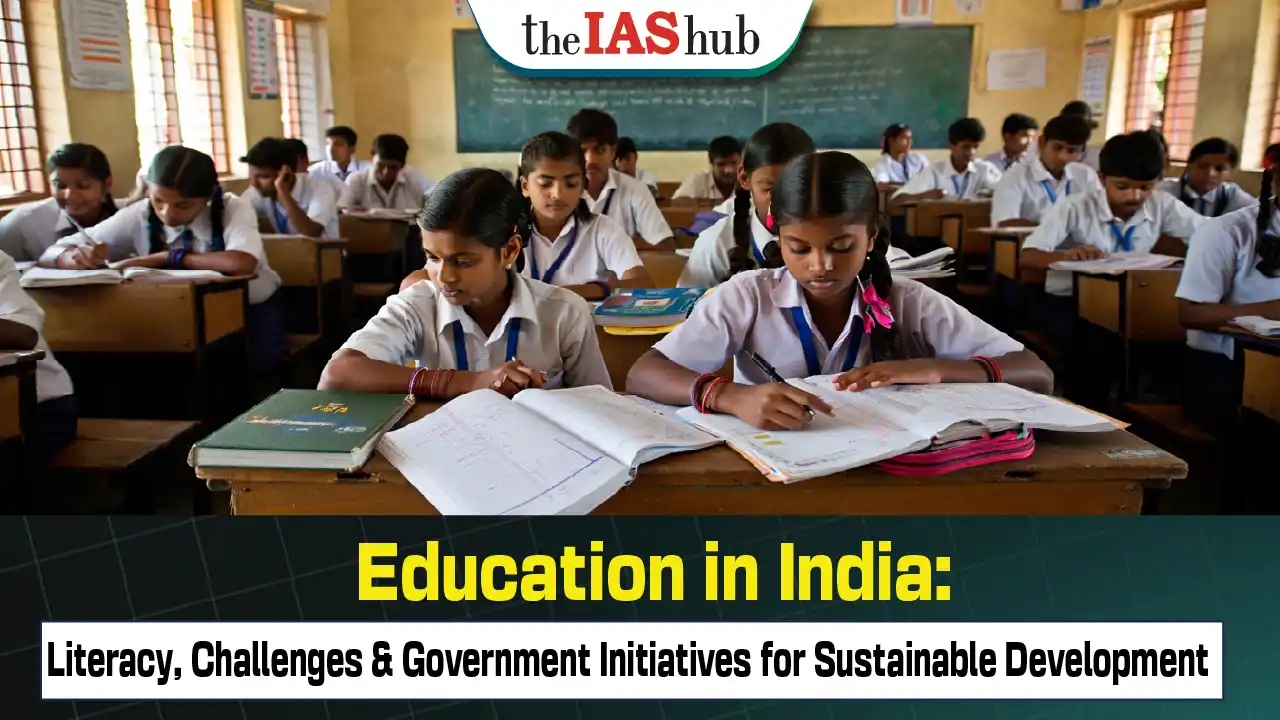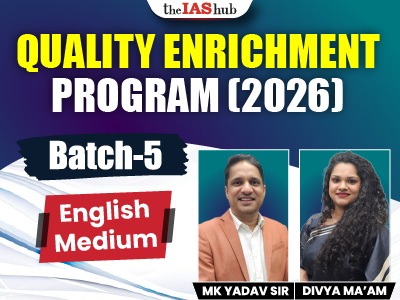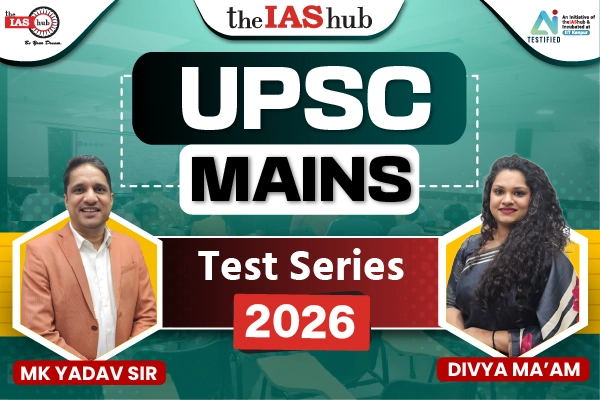The key to establishing peace, eliminating poverty, and promoting sustainable development is education, which transforms lives. All people have a right to an education throughout their lives, and that access must be matched by quality.
|
GENERAL FACTS: EDUCATION IN INDIA
|
|
Literacy rate
(Census 2011 & NSS Report)
|
- All India – 74%, Males – 82%, Females – 65%
- Rural – 74%, Urban - 88%
|
|
Adult Illiteracy in India
(15 years & above)
|
- Adult Non Literates – >20 crore (largest population of illiterate adults in the world)
|
Gross Enrolment Ratio
(MoE, UDISE 2021-22)
|
|
Level
|
(2021-22)
|
|
Primary (I-V)
|
103%
|
|
Upper Primary (VI - VIII)
|
95%
|
|
Secondary (IX - X)
|
80%
|
|
Senior Secondary (XI - XII)
|
58%
|
|
Higher Education (AISHE, 2019-20)
|
27%
|
GER of girls across all levels of education is now higher than boys.
|
|
Out-of-school Children (6-17 yrs) (NSSO)
|
More than 3 crore.
|
|
Expenditure on Education
|
|
|
Higher Education
|
- Total Enrolment: Female - 49%, Male – 51%
- Colleges in Private Sector – >75%, but it caters to only 65% of the total enrolment.
- Foreign Student Enrolment: Highest share from neighbouring countries like Nepal, Afghanistan, Bangladesh, Bhutan & African countries like Sudan & Nigeria
|
Constitutional Provisions for Education in India
- The 86th Amendment to the Constitution: the 86th Amendment to the Constitution provided the Right to Education as a fundamental right.
- The amendment inserted Article 21A, which made the RTE a fundamental right for children aged between six and 14 years.
- The passage of the amendment was followed by the launch of the Sarva Shiksha Abhiyan (SSA), a central government scheme implemented in partnership with the state governments that aimed to provide “useful and relevant, elementary education’’ to all children between six and 14 years.
- In 2006, the 93rd Constitution Amendment Act: 93rd Constitution Amendment Act inserted Clause (5) in Article 15 which enabled the State to create special provisions, such as reservations for advancement of any backward classes of citizens like Scheduled Castes and Scheduled Tribes, in all aided or unaided educational institutes, except minority educational institutes.
- RTE Act,2009: The government subsequently brought the Right to Education (RTE) Act, 2009, which centres around inclusive education for all, making it mandatory to include underprivileged children in schools.
- Specifically, Section 12(1)(c) of the Act provided for 25 percent reservation of seats in unaided schools for admission of children from economically weaker sections and disadvantaged groups.
Facts on Education in India
- As per a National Commission for Protection of Child Rights (NCPCR) report, only 4.18% of total students received benefits such as freeships, free uniforms and books, scholarships, etc..
- The literacy rate was 74.04% (2011 Census), with 82.14 percent of men and 65.46 percent of women. Kerala leads with a literacy rate of 93.91%, while Bihar comes in lowest (61.8%).
- Overall, the GER for higher education has increased from 24.1 percent in 2016-17 to 27.3 percent in 2020-21.
Challenges in Education in India
- Financial Issues: Parents tend to see education as an expense rather than an investment. They would rather have the children work and earn. When it comes to higher education, lack of good institutes close by means students have to look at shifting to cities, which adds to their expenses.
- Lack of guidance: Students in smaller regions have great potential and are motivated to study but lack right mentoring.
- Gender inequality: In some places, girls are not allowed to go to school. Or if allowed, it is only up to a certain age.
Government Initiatives for Education in India
Education is in the concurrent list of the Constitution and majority of the schools are under the domain of respective State and UT Governments. However, to ensure that every student gets continued access to education, a multi-pronged approach has been adopted.
- The National Education Policy, 2020: is meant to provide an overarching vision and comprehensive framework for both school and higher education across the country.
- The NEP proposes to change the school curricular structure from the current 10+2 (Class 1-10 of general education followed by two years of higher secondary school with specialised subjects) with a 5+3+3+4 structure, bringing children from ages 3 to 5 years within the formal education system.
- For higher education, a new umbrella regulator has been proposed with separate verticals for regulation, standard setting, accreditation and funding.
- Top foreign universities will be allowed to set up campuses in India.
- For students, the biggest change may be the introduction of four-year undergraduate degrees, with options for entry and exit at various stages.
- The National Foundational Literacy and Numeracy Mission will to be implemented by 2025.
- The National Council of Educational Research and Training (NCERT) will introduce the curricular framework for the new school structure, including early childhood care.
- Shishak Parv: Implementation of the National Education Policy, including a 10,000-word dictionary for Indian Sign Language and a talking books project for visually impaired students.
- A teacher training programme for early childhood education, a standard setting authority for the Central Board of Secondary Education and the Vidyanjali 2.0.
- New India Literacy Programme: Government approved a new scheme “New India Literacy Programme for the period FYs 2022-2027 to cover all the aspects of Adult Education to align with National Education Policy 2020.
- critical life skills, vocational skills, basic education, and continuing education including culture, sports, and recreation, as well as other topics of interest or use to local learners, such as more advanced material on critical life skills.
- NATIONAL CURRICULUM FRAMEWORK FOR FOUNDATIONAL STAGE
- The National Education Policy (NEP), 2020, calls for the development of the four NCFs listed below.

- Goal: Contribute to the improvement of the educational system as envisioned by NEP 2020.
- It will serve as the foundation for all pedagogy used by educational institutions, such as kindergartens and anganwadis, for students in grades nursery through two.
- Learning Poverty: According to a World Bank official, the COVID-19 pandemic has caused a sharp increase in India's learning poverty.
- According to World Bank simulation statistics, before the pandemic, roughly 53% of kids couldn't read a basic sentence by the time they turned 10, but after the pandemic, that number rose to 70%.
- Because they were born in particular years and between the ages of five and 18, this generation will suffer more than the one before it and the one after it.
- PM e-VIDYA: PM e-VIDYA has been initiated as part of Atma Nirbhar Bharat Abhiyan on 17th May, 2020, which unifies all efforts related to digital/online/on-air education to enable multi-mode access to education. The initiative includes:
- DIKSHA (one nation, one digital platform) is the nation’s digital infrastructure for providing quality e-content for school education in states/UTs and QR coded Energized Textbooks for all grades are available on it.
- One earmarked Swayam Prabha TV channel per class from Class 1 to 12 (one class, one channel).
- Extensive use of Radio, Community radio and CBSE Podcast- Shiksha Vani.
- Special e-content for visually and hearing impaired developed on Digitally Accessible Information System (DAISY) and in sign language on NIOS website/ YouTube.
- Mid-Day-Meal (MDM): Mid-Day Meal Scheme (MDMS) is an on-going Centrally-Sponsored Scheme which provides nutritional supplement to all school children studying in Classes I-VIII of Government, Government-Aided schools, Special Training Centres including Madarsas and Maqtabs.
- Samagra Shiksha: The Government of India launched Samagra Shiksha-an Integrated Scheme for school education, which aims to ensure inclusive and equitable quality education at all levels of school education, across the country including the rural areas.
Way Forward
- People in Delhi and beyond have become interested in the Delhi educational paradigm over the past five years. It developed a plan that, in essence, consists of five key parts and is funded by over 25% of the State Budget. The subsequent set of reforms now have a path thanks to the validation of this paradigm.
- we have witnessed learning consortiums and coalitions taking shape, with diverse stakeholders — including governments, publishers, education professionals, technology providers, and telecom network operators — coming together to utilise digital platforms as a solution to the education crisis.
- The allocation for the Saksham Anganwadis scheme could be key to building the capacity of anganwadi workers, who are primarily health workers, to ensure they can provide children with a holistic learning foundation.
- Ed -tech: The Central Government has been explicit in its digital push across sectors, and the budget reflects that for the education sector as well. The majority of the budget announcements for education were EdTech-related.
Conclusion
While the road ahead is likely to have several speed breakers, a concerted strategy around promoting cross learning among different stakeholders, identifying some of the best practices and implementing them to optimize the existing funds can allow us to navigate them. Successfully implementing these can help us build back our schools better, support children with uninterrupted learning.












